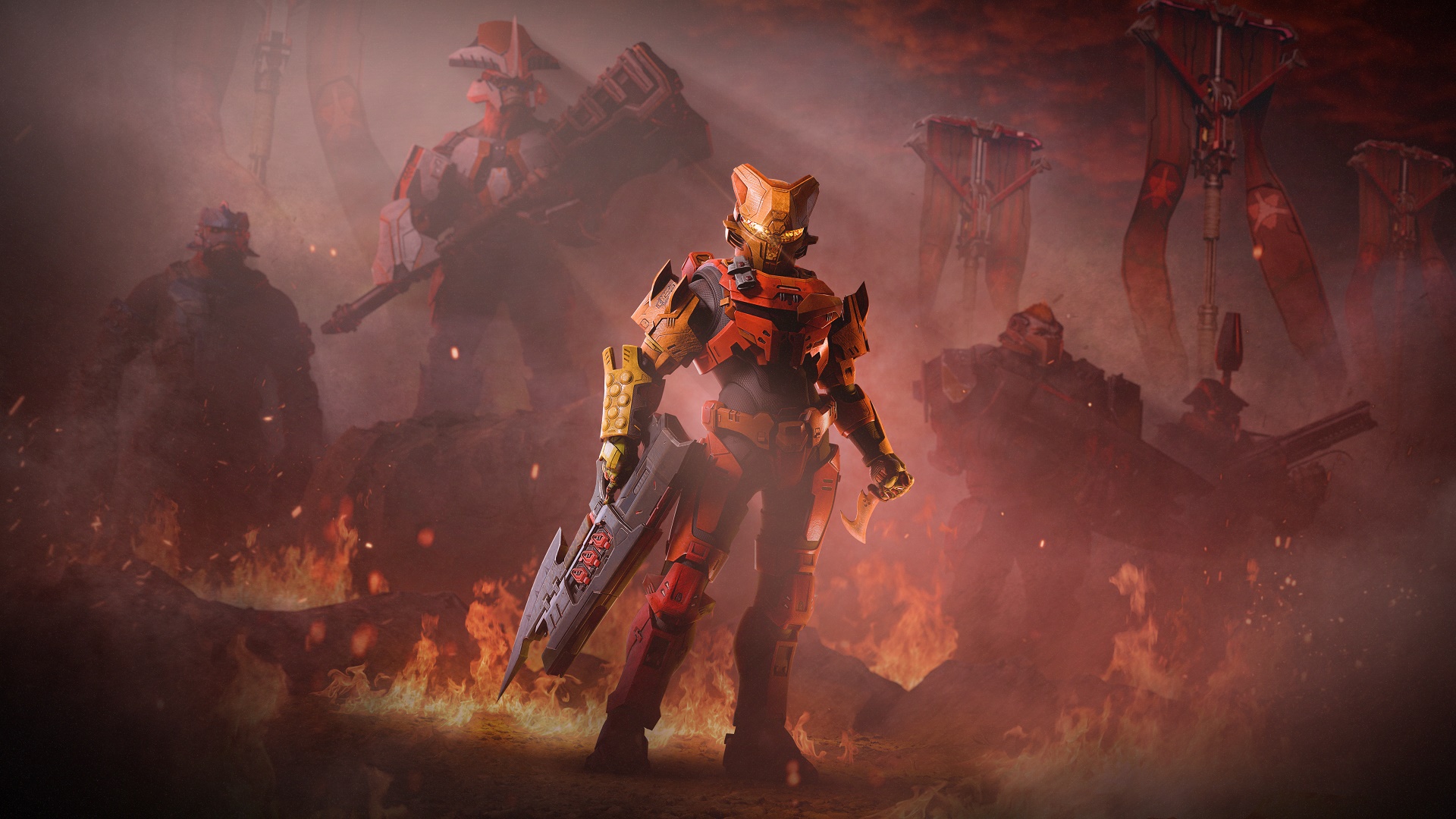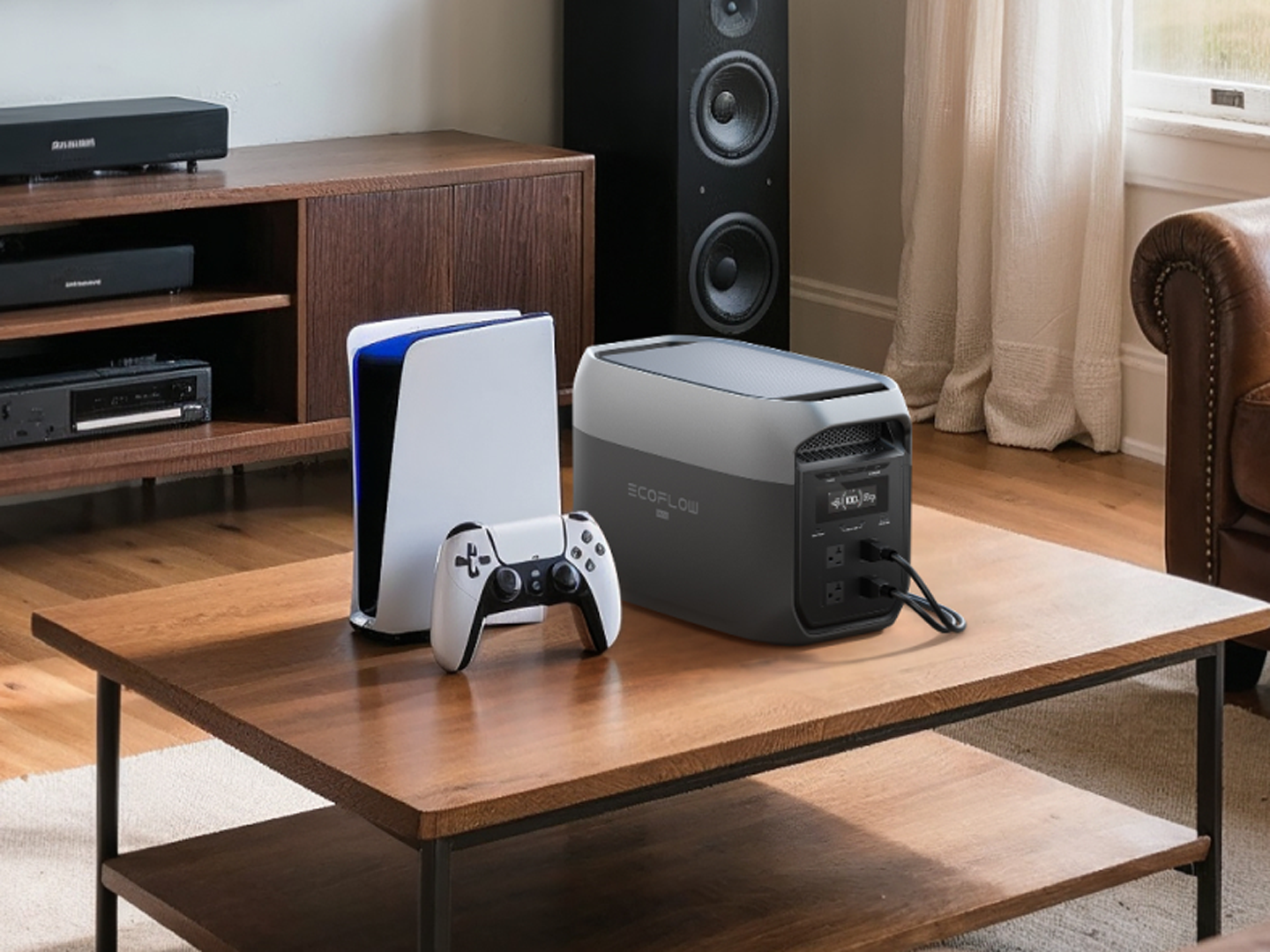
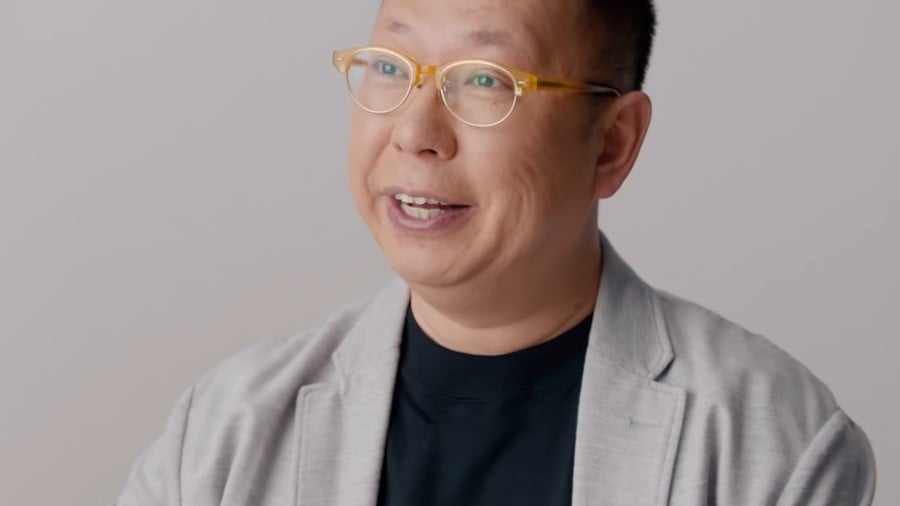
Takashi Tezuka seems like a good laugh, the kind of chap who knows how to have fun.
Despite all the Master-Sword-waving and PR-related hijinx from fellow Nintendo luminary Shigeru Miyamoto over the years, you still get the impression he’s merciless in the workplace — an exacting, intimidating, tea-table-upending taskmaster — whereas Tezuka has an air of merrymaking and mischief about him.
Although the combined talents of Miyamoto, Tezuka, and programmer Toshihiko Nakago are cited (not least by Satoru Iwata) as the ‘Golden Triangle’ that birthed both the Mario and Zelda series, Miyamoto and Tezuka have become the poster-boy pair for Nintendo’s ’80s output.
Tezuka, who is now Executive Officer of Nintendo EPD (Entertainment Planning & Development), joined the Kyoto company 40 years ago this month, and regardless of their individual demeanours, one thing is clear: their game design instincts and precise approaches gel beautifully. Tezuka and Miyamoto formed a formidable design duo back in the mid-’80s, one which — along with their many talented colleagues — shaped the industry. Yet despite his enormous impact, his contributions aren’t as celebrated as many of his counterparts.
Comes out swinging
Born on 17th November 1960, ‘TENTEN’ — as he was nicknamed, and sometimes credited — graduated from Osaka University of Arts, an institution which counts Fumito Ueda (ICO, Shadow of the Colossus) and fellow Nintendo employees Koji Kondo, Kenji Yamamoto, and Yoshiaki Koizumi among its alumni. Tezuka’s first job at Nintendo was working on the arcade release Super Punch-Out!!, a part-time gig while still a student. “I helped out with some of the pixilated [sic] images,” he said during an Iwata Asks interview, “just for a period of a few weeks.”
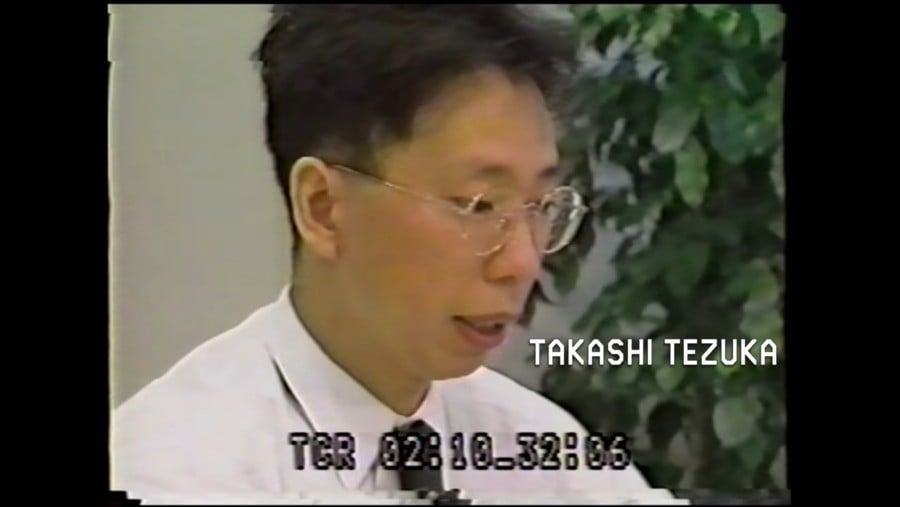
Before long, the 23-year-old graduated and joined Nintendo full-time in April 1984. A friend who applied to work there had initially piqued Tezuka’s interest in the company, though it didn’t stem from a particular love of video games, but a wider “interest in jobs related to leisure and recreation.”
Tezuka: I was interested in getting involved in designing goods branded with characters’ images. Students who’d studied design at university would often go on to work for printing companies or advertising agencies. But I wasn’t particularly interested in the kind of jobs where you would first get a client, then design things in line with their requirements…
Iwata: You wanted to make things for yourself.
Tezuka: That’s right. I felt really strongly about that.
His first full-time task was working on Devil World, a Pac-Man-style maze game (now available to play via Nintendo Switch Online), although Tezuka admitted that he hadn’t heard of Pac-Man at the time. The Famicom launched in 1983 but he wasn’t familiar with Nintendo’s console, either. “I didn’t have any knowledge of this thing called the Family Computer (Famicom),” he recalled during an NES Classic Mini interview, “so I thought it was like a home computer!”
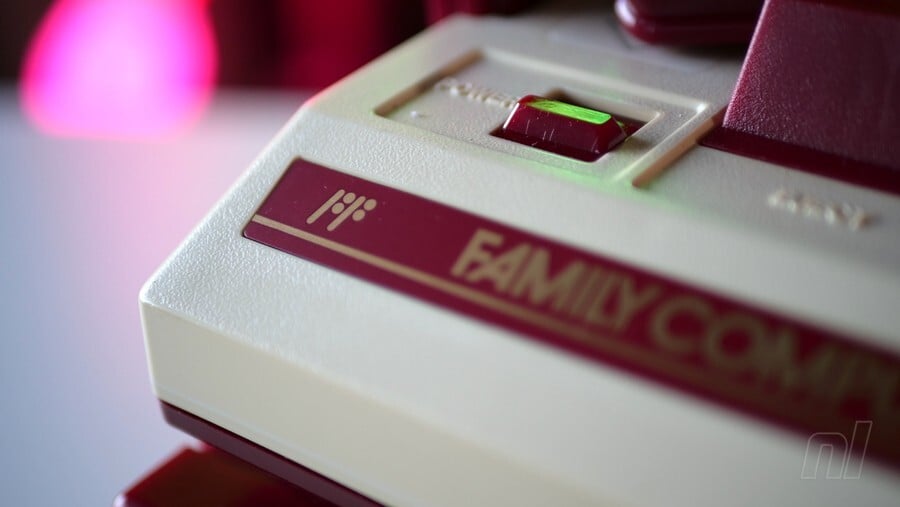
Tezuka’s lack of video gaming nous wasn’t an issue; after lending a hand with Excitebike, his next assignment saw him designing and directing a little game called Super Mario Bros. alongside Miyamoto, who had been at Nintendo since 1977. “I was doing design work all on my own,” he told Akinori Sao, “so Tezuka-san’s arrival was a big help.”
In fact, while Miyamoto always had plans to use Mario — or “Mr. Video” — in all his games, the idea to use the plumber in this platformer was helped along by Tezuka-san, thanks to his sociable spirit and lunchtime chats with the sales department. Speaking with Satoru Iwata in 2009 about how the 16×32 pixel block from the prototype became Mario:
Tezuka: Next door to the development room was the Sales and Marketing Division. The head of that department at the time was a pretty approachable guy, and though it might be hard to imagine it happening nowadays, I got him to show me the sales figures […] At lunchtime I’d often wander to various places and chat to people from other departments. So I’d become friendly with people that way. Anyway, I was shown the sales figures and I saw that although Mario Bros. on the Famicom had been released over a year previously, it was still selling consistently well.
Iwata: So you saw those sales figures and a light bulb lit up above your head?
Tezuka: Right. I thought: “This Mario is pretty popular.” I recall that I mentioned to Miyamoto-san that Mario was selling consistently well and he said, “Mario seems like the way to go.”
Second quest

If Tezuka’s rapid rise through Nintendo’s ranks — going from newbie graduate to Assistant Director on the company’s most ambitious game in a matter of months — feels improbable by today’s standards, it’s worth remembering not just Miyamoto’s relief at finally sharing the design workload, but also how different that nascent era of console game development was. Nintendo had “very few designers on the staff” in those early Famicom days and new recruits would be employed across different projects in different capacities as needed.
“We did all kinds of things such as working on instruction manuals and designing playing cards,” Tezuka told Iwata, which included arcade cabinet art. “At that time, everyone put their heads together, collected their ideas and made the games in an amateur spirit. So I would also come up with ideas.”
He quickly established an excellent working relationship with Miyamoto and the team, as evidenced by the games themselves. Following Super Mario Bros., the developers segued into another little project, The Legend of Zelda. “Back then we had some long paper, and Tezuka-san and Miyamoto-san would sit side-by-side and draw together,” recalled programmer Nakago in another Iwata Asks interview.
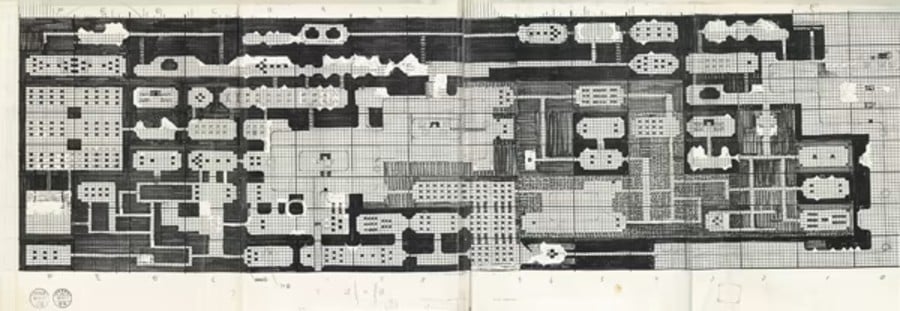
Nakago: You drew the stuff on the left, Tezuka-san, and the right side is Miyamoto-san’s. If you look closely, you can tell how marker was used to make small dots. These are rocks, and these are trees. And you can see Miyamoto-san’s personality. At first he’s making individual dots, but as he gets tired of it, toward the top, he just fills in a bunch of space!
Aonuma: Yeah, the left and right sides do look different.
Tezuka: They really are different somehow.
Iwata: And they drew this all in one sitting.
Within just two years, Tezuka had helped develop and ship two iconic titles — games that would become the company’s tentpole brands and lay the foundations not just for Nintendo’s future, but for the video game industry itself. Excluding the previously mentioned genre-definers, credits from the first decade of his career include Super Mario Bros. 3 (director, designer), Super Mario World (director), Zelda: A Link to the Past (director), and Zelda: Link’s Awakening (director). 1995’s Yoshi’s Island was his last Super Famicom directorial credit, after which, following assistant directorial work on Super Mario 64, he was promoted into supervisory and producing roles in the N64 era.
It’s worth taking a moment to re-read those credits. You’ll frequently find those all-timers topping ranked software lists from players and developers alike. In a single decade, Tezuka went from being unable to point out Pac-Man in a lineup to shifting our understanding of what video games could be. It’s a truly remarkable turnaround.
Tag team trouble
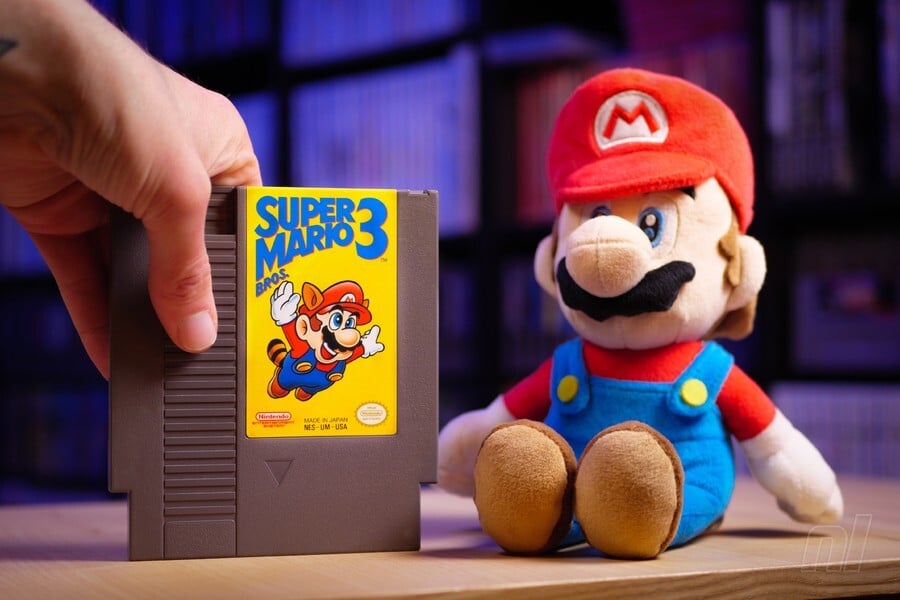
Back to the ’80s, though. After writing for The Adventure of Link, Tezuka helmed the celebrated Super Mario Bros. 3, the last Mario entry for which he drew the in-game character artwork. When the 16-bit era arrived, “there were just a lot of people that were better than me.”
Speaking to Ars Technica, he revealed a special attachment to this game, an affection that likely stems from its difficult gestation. Created over two and a half years — an eternity in 8-bit development terms — he originally envisioned viewing the platformer “looking down diagonally from overhead rather than directly from the side.” Having directed Super Mario Bros. 2 (the Japanese sequel known as The Lost Levels in the West), which followed the template of the original very precisely while increasing the challenge for veterans, he was eager to try something new.
However, viewed from that perspective, problems arose around knowing exactly when Mario’s feet hit the ground. “It wouldn’t come together well, and [development] dragged on.”
Tezuka: We were experimenting with a bunch of things, and in the end…
Miyamoto: We started talking about how to pull it all together and I joined in to help adjust it.
Reading between the lines, it seems Miyamoto’s years of development expertise may have come into play here, tempering the less-experienced Tezuka’s ambition and getting the project back on track by reverting to the side-on perspective.

Fortunately, that course correction led to another NES classic — one which features the first appearance of ghost enemy Boo, a character whose behaviour Tezuka famously based on his wife, Sumi. As Miyamoto put it when discussing Super Mario 64 with Nintendo Power: “His wife is very quiet normally, but one day she exploded, maddened by all the time he spent at work.” Tezuka was inspired to make Boo grow “large and menacing” when Mario turns his back. “She knows,” he laughed when asked how his spouse felt about the cheeky homage.
Tezuka’s influence was felt — and still is — in later Mario and Zelda series entries in which he was less involved. The 3D Zeldas would follow the same basic Link to the Past formula for 20 years, but his fingerprints are all over the series. His introduction of “suspicious types” in Link’s Awakening, for instance, was “an important element in the series making a breakthrough,” according to Eiji Aonuma, who believes that “Ocarina of Time would have been different,” had the series moved directly from Super NES to N64.


Takashi Tezuka seems like a good laugh, the kind of chap who knows how to have fun.
Despite all the Master-Sword-waving and PR-related hijinx from fellow Nintendo luminary Shigeru Miyamoto over the years, you still get the impression he’s merciless in the workplace — an exacting, intimidating, tea-table-upending taskmaster — whereas Tezuka has an air of merrymaking and mischief about him.
Although the combined talents of Miyamoto, Tezuka, and programmer Toshihiko Nakago are cited (not least by Satoru Iwata) as the ‘Golden Triangle’ that birthed both the Mario and Zelda series, Miyamoto and Tezuka have become the poster-boy pair for Nintendo’s ’80s output.
Tezuka, who is now Executive Officer of Nintendo EPD (Entertainment Planning & Development), joined the Kyoto company 40 years ago this month, and regardless of their individual demeanours, one thing is clear: their game design instincts and precise approaches gel beautifully. Tezuka and Miyamoto formed a formidable design duo back in the mid-’80s, one which — along with their many talented colleagues — shaped the industry. Yet despite his enormous impact, his contributions aren’t as celebrated as many of his counterparts.
Comes out swinging
Born on 17th November 1960, ‘TENTEN’ — as he was nicknamed, and sometimes credited — graduated from Osaka University of Arts, an institution which counts Fumito Ueda (ICO, Shadow of the Colossus) and fellow Nintendo employees Koji Kondo, Kenji Yamamoto, and Yoshiaki Koizumi among its alumni. Tezuka’s first job at Nintendo was working on the arcade release Super Punch-Out!!, a part-time gig while still a student. “I helped out with some of the pixilated [sic] images,” he said during an Iwata Asks interview, “just for a period of a few weeks.”

Before long, the 23-year-old graduated and joined Nintendo full-time in April 1984. A friend who applied to work there had initially piqued Tezuka’s interest in the company, though it didn’t stem from a particular love of video games, but a wider “interest in jobs related to leisure and recreation.”
Tezuka: I was interested in getting involved in designing goods branded with characters’ images. Students who’d studied design at university would often go on to work for printing companies or advertising agencies. But I wasn’t particularly interested in the kind of jobs where you would first get a client, then design things in line with their requirements…
Iwata: You wanted to make things for yourself.
Tezuka: That’s right. I felt really strongly about that.
His first full-time task was working on Devil World, a Pac-Man-style maze game (now available to play via Nintendo Switch Online), although Tezuka admitted that he hadn’t heard of Pac-Man at the time. The Famicom launched in 1983 but he wasn’t familiar with Nintendo’s console, either. “I didn’t have any knowledge of this thing called the Family Computer (Famicom),” he recalled during an NES Classic Mini interview, “so I thought it was like a home computer!”

Tezuka’s lack of video gaming nous wasn’t an issue; after lending a hand with Excitebike, his next assignment saw him designing and directing a little game called Super Mario Bros. alongside Miyamoto, who had been at Nintendo since 1977. “I was doing design work all on my own,” he told Akinori Sao, “so Tezuka-san’s arrival was a big help.”
In fact, while Miyamoto always had plans to use Mario — or “Mr. Video” — in all his games, the idea to use the plumber in this platformer was helped along by Tezuka-san, thanks to his sociable spirit and lunchtime chats with the sales department. Speaking with Satoru Iwata in 2009 about how the 16×32 pixel block from the prototype became Mario:
Tezuka: Next door to the development room was the Sales and Marketing Division. The head of that department at the time was a pretty approachable guy, and though it might be hard to imagine it happening nowadays, I got him to show me the sales figures […] At lunchtime I’d often wander to various places and chat to people from other departments. So I’d become friendly with people that way. Anyway, I was shown the sales figures and I saw that although Mario Bros. on the Famicom had been released over a year previously, it was still selling consistently well.
Iwata: So you saw those sales figures and a light bulb lit up above your head?
Tezuka: Right. I thought: “This Mario is pretty popular.” I recall that I mentioned to Miyamoto-san that Mario was selling consistently well and he said, “Mario seems like the way to go.”
Second quest

If Tezuka’s rapid rise through Nintendo’s ranks — going from newbie graduate to Assistant Director on the company’s most ambitious game in a matter of months — feels improbable by today’s standards, it’s worth remembering not just Miyamoto’s relief at finally sharing the design workload, but also how different that nascent era of console game development was. Nintendo had “very few designers on the staff” in those early Famicom days and new recruits would be employed across different projects in different capacities as needed.
“We did all kinds of things such as working on instruction manuals and designing playing cards,” Tezuka told Iwata, which included arcade cabinet art. “At that time, everyone put their heads together, collected their ideas and made the games in an amateur spirit. So I would also come up with ideas.”
He quickly established an excellent working relationship with Miyamoto and the team, as evidenced by the games themselves. Following Super Mario Bros., the developers segued into another little project, The Legend of Zelda. “Back then we had some long paper, and Tezuka-san and Miyamoto-san would sit side-by-side and draw together,” recalled programmer Nakago in another Iwata Asks interview.

Nakago: You drew the stuff on the left, Tezuka-san, and the right side is Miyamoto-san’s. If you look closely, you can tell how marker was used to make small dots. These are rocks, and these are trees. And you can see Miyamoto-san’s personality. At first he’s making individual dots, but as he gets tired of it, toward the top, he just fills in a bunch of space!
Aonuma: Yeah, the left and right sides do look different.
Tezuka: They really are different somehow.
Iwata: And they drew this all in one sitting.
Within just two years, Tezuka had helped develop and ship two iconic titles — games that would become the company’s tentpole brands and lay the foundations not just for Nintendo’s future, but for the video game industry itself. Excluding the previously mentioned genre-definers, credits from the first decade of his career include Super Mario Bros. 3 (director, designer), Super Mario World (director), Zelda: A Link to the Past (director), and Zelda: Link’s Awakening (director). 1995’s Yoshi’s Island was his last Super Famicom directorial credit, after which, following assistant directorial work on Super Mario 64, he was promoted into supervisory and producing roles in the N64 era.
It’s worth taking a moment to re-read those credits. You’ll frequently find those all-timers topping ranked software lists from players and developers alike. In a single decade, Tezuka went from being unable to point out Pac-Man in a lineup to shifting our understanding of what video games could be. It’s a truly remarkable turnaround.
Tag team trouble

Back to the ’80s, though. After writing for The Adventure of Link, Tezuka helmed the celebrated Super Mario Bros. 3, the last Mario entry for which he drew the in-game character artwork. When the 16-bit era arrived, “there were just a lot of people that were better than me.”
Speaking to Ars Technica, he revealed a special attachment to this game, an affection that likely stems from its difficult gestation. Created over two and a half years — an eternity in 8-bit development terms — he originally envisioned viewing the platformer “looking down diagonally from overhead rather than directly from the side.” Having directed Super Mario Bros. 2 (the Japanese sequel known as The Lost Levels in the West), which followed the template of the original very precisely while increasing the challenge for veterans, he was eager to try something new.
However, viewed from that perspective, problems arose around knowing exactly when Mario’s feet hit the ground. “It wouldn’t come together well, and [development] dragged on.”
Tezuka: We were experimenting with a bunch of things, and in the end…
Miyamoto: We started talking about how to pull it all together and I joined in to help adjust it.
Reading between the lines, it seems Miyamoto’s years of development expertise may have come into play here, tempering the less-experienced Tezuka’s ambition and getting the project back on track by reverting to the side-on perspective.

Fortunately, that course correction led to another NES classic — one which features the first appearance of ghost enemy Boo, a character whose behaviour Tezuka famously based on his wife, Sumi. As Miyamoto put it when discussing Super Mario 64 with Nintendo Power: “His wife is very quiet normally, but one day she exploded, maddened by all the time he spent at work.” Tezuka was inspired to make Boo grow “large and menacing” when Mario turns his back. “She knows,” he laughed when asked how his spouse felt about the cheeky homage.
Tezuka’s influence was felt — and still is — in later Mario and Zelda series entries in which he was less involved. The 3D Zeldas would follow the same basic Link to the Past formula for 20 years, but his fingerprints are all over the series. His introduction of “suspicious types” in Link’s Awakening, for instance, was “an important element in the series making a breakthrough,” according to Eiji Aonuma, who believes that “Ocarina of Time would have been different,” had the series moved directly from Super NES to N64.

Calling the (hook)shots
Throughout the latter half of the 1990s and into the 2000s, Tezuka was busy as a Supervisor or Producer on some of Nintendo’s biggest series, including Zelda, Mario Kart, Pikmin, Yoshi, and Animal Crossing. He oversaw external companies’ work on Nintendo franchises (“They struck me as being very jock-like. (laughs) Not at all like us,” he said of the Capcom team he worked with on the Oracle Zelda games), produced smaller projects such as Flipnote Studio, and steered 2D Mario through the Wii/DS era, helping a new generation of developers understand the secret sauce which sets Mario apart.
One of “the two engineers who assisted television crews to get their footage” during Nintendo SpaceWorld ’95. 😇 https://t.co/4Cp0n5kkHe pic.twitter.com/dyMQq2yRil— Nintendo Memories (@NintendoMemo) March 21, 2024
While Miyamoto would frequently pop up at E3 or alongside Iwata as the Nintendo Direct era approached, and Zelda boss Eiji Aonuma became a familiar name to Nintendo fans, Tezuka — at least from the perspective of Western media — kept a lower profile. That was until 2015’s Super Mario Maker, which saw him on the road with Miyamoto speaking to world media and reminiscing about Super Mario Bros. 30 years on.
The project not only brought his history and expertise with the series to the fore, but also the player-first, creative approach to game design he had been honing over three decades.
“I’m not content with making a game that has a story that you just follow from beginning to end,” he told Jeremy Parish in the run-up to release. “My philosophy is to create a game that offers many different elements and let the player experience those different things in whatever combination they like […] I want all my games to engage people’s imaginations and sense of creativity.”
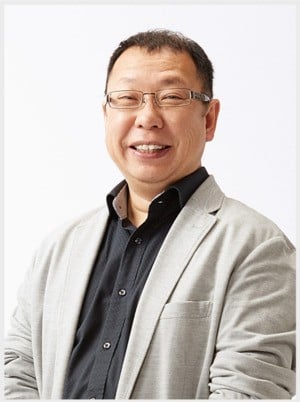
In his GDC 2024 talk with Shiro Mouri, Tezuka touched again on this dislike of linear, one-and-done courses in the context of Super Mario Bros. Wonder — games that don’t let you go back and explore new routes and engage creatively with the software. Discussing the concept of ‘mottainai‘ — a Japanese term akin to ‘What a waste!’ — he spoke of specific design choices to encourage experimentation, and how departments sharing their thoughts with the entire team can help avoid missed opportunities:
“I believe that leads of different disciplines can influence each other’s work in ways that infuse courses with life. When teams don’t do this, it’s hard to make the most of the game spec and that’s what we call ‘mottainai’ […] To put it simple, it means when you aren’t able to make the most of somethine and you feel regret or frustration that it’s gone to waste. Is what you spent so much time creating in development working the way it’s supposed to in the game?”
It seems Tezuka-san is still working on design problems he sees in the linear 2D Mario template, frustrations which stretch back to at least 1988. “We put a lot of courses in Super Mario Bros. 3, but when there are lots of courses, you tend to move right on to the next one every time you clear one […] each course is packed full of game elements.”
Speaking in a Super Mario 3D Land interview, Iwata commented to director Koichi Hayashida, “I heard that Tezuka-san said some pretty harsh things to you,” hinting that despite outward appearances Tezuka may be just as exacting as Miyamoto when it comes to feedback and getting what he wants.
Hayashida: I think what Tezuka-san pays the most attention to in a video game is how fun it is, how good it feels. So I just recently realized that’s the reason he doesn’t want to go back and collect coins. […] In New Super Mario Bros. Mega Mario tromps along defeating enemies. That was an awful thing to do to the people who made the course!
Iwata: Because Mario is destroying game mechanics! (laughs)
Hayashida: But I think he just thinks, “It’s fun, so it’s okay!”
Iwata: The phrase, “It’s fun, so it’s okay!” really does fit Tezuka-san. (laughs)
Indeed, it’s the similarities between Tezuka and Miyamoto that stand out looking at their work and philosophies. They both have a similar disregard for the hows and whys of a particular gameplay mechanic or character choice, as long as the effect is a pleasing one. The player’s enjoyment is paramount, whether that involves putting tails on everything just because it’s funny, or making coin collection automatic when you squash a Goomba, because making you run back to collect them felt “ungenerous”. Fun is a serious business.
“I love my job”
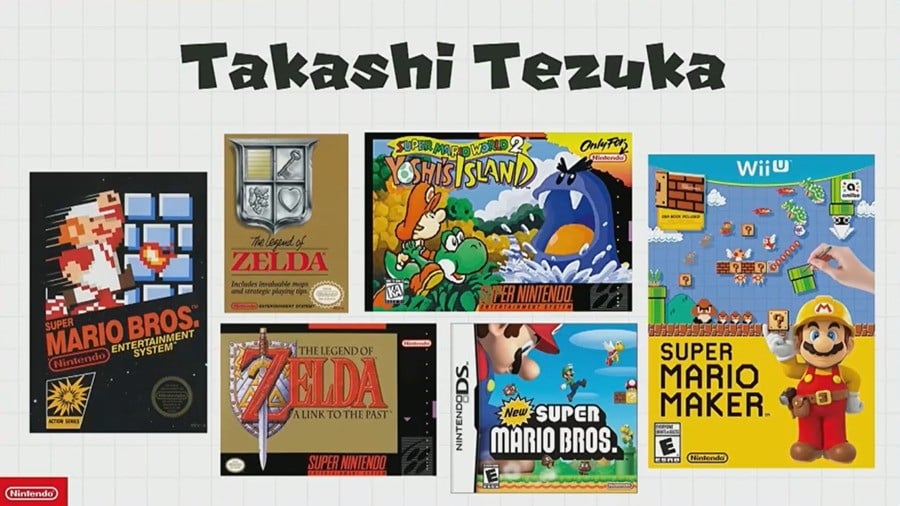
After 40 years at Nintendo, and at the age of 63, you could understand if Tezuka was considering retirement. Across four decades, he’s probably forgotten more about game design than most devs will ever know — at least if Iwata’s friendly jibes about his memory are anything to go by. Reading interviews, there’s a sense that younger Nintendo employees have been benefitting from his old-guard expertise for many years now. His fun-first spirit is part of the company’s DNA and its mission statement to “surprise and delight,” so we wouldn’t blame him for looking back on an impressive legacy and deciding to put his feet up.
However, if the sentiment he expressed to Bloomberg back in 2007 holds true, we can’t imagine he’s keen to give up his passion just yet:
“I have always been trying to make games so that anyone — as many people as possible — can enjoy them… I cannot help but say that I love my job of making games from the bottom of my heart.”
Back in 1990, in the Super Mario World official guidebook of all places (as translated by Shmupulations), he spoke of the future. “I want to make games that no matter how many times you clear them, you want to keep that game and hold onto it like a treasure.”
Looking back on 40 years of remarkable work, we’ve got a trove of those treasures — too many to hold — and they’re still coming. Job done, Tezuka-san.



